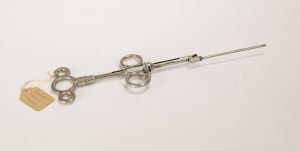The BackBlog: J. W. Farlow’s Tools for Tonsillectomy
As I sorted through boxes of ear, nose, and throat instruments, I was excited to discover a clear collection forming. There were numerous instruments that had been carefully tagged with a description of the instrument and the name “Dr. J. W. Farlow”. This was particularly exciting because it wasn’t only a clear collection, but it all revolved around one particular subject. Before I knew anything about who J. W. Farlow was, I knew based on his collection that he was almost certainly a laryngologist.
What was even more exciting was when I began looking at the names on the objects. Amongst objects with names like “Hajeck’s nasal punch” and “Roe’s septum forceps”, I found an object labeled “Farlow tonsil ecraseur”. J. W. Farlow wasn’t just a doctor, he was also an inventor.

Farlow Tonsil Ecraseur. From the Warren Anatomical Museum in the Center for the History of Medicine, Francis A. Countway Library of Medicine (WAM 22220)
The instruments belonged to Dr. John Woodford Farlow (1853-1937), who was a laryngologist in Boston. At the time that Farlow was practicing, tonsillectomy—surgical removal of the tonsils—was a common procedure. In the early 20th century it was the most frequently practiced surgical procedure in the United States and would have made up a large portion of a laryngologist’s work. Because of this, there were many innovations in the tools used for these surgeries. Farlow made his mark with his tonsil forceps and the tonsil ecraseur (or tonsil snare) that is part of our collection.
The tonsil ecraseur was an alternative to the tonsillotome or tonsil guillotine, allowing the physician to remove the tonsils in their entirety. It was often favored over other instruments because it removed the tonsils cleanly and because many believed—although it was disputed—that it reduced the chances of hemorrhage during surgery. Farlow’s ecraseur had a straight handle with a “cold wire”, meaning there was no heating element like some other devices. The wire was attached to a screw that could be rotated using the finger loops at the end of the handle. This allowed the physician using the device to carefully and gradually pull the wire, which gave Farlow’s design a distinct advantage over lever-based snares, which did not offer as much control.
Farlow was associated with many hospitals in the Boston area throughout his career, including the Boston Dispensary, the Staniford Street Dispensary, the Free Dispensary for Diseases of Women, and the Boston City Hospital. He was on the Harvard Medical School faculty as a Clinical Instructor of Laryngology from 1892-1906. In 1902 he served as President of the American Laryngological Society. He was also very involved in the Boston Medical Library, which was the subject of most of his publications. Because of this, he is remembered more as a librarian than a laryngologist. His tonsil ecraseur and the rest of his collection are a reminder of his important contributions to his medical field.